I’ll never forget stepping onto Zlatni Rat in Croatia. The water was crystal clear, and the sand was golden. It showed me European beaches are truly special.
My search for Europe’s cleanest beaches started in Croatia. I’ve seen many shores since then. Each one had its own charm and cared for nature.
I was amazed by the eco-friendly beaches I found. Some had blue flags, others used new ways to protect the environment. Many were safe for families, offering fun for kids and peace for parents.
Traveling, I learned when to visit these beautiful beaches. Some places like Tenerife in Spain are great all year. Others are best from spring to early fall. So, you can always find a great beach to visit.
Key Takeaways
- European beaches offer diverse experiences from Mediterranean to Atlantic coasts
- Many beaches hold eco-friendly certifications and practice sustainable tourism
- Crystal-clear water and clean sand are hallmarks of Europe’s top beaches
- Family-safe beaches are abundant, with activities for all ages
- Best visiting times vary, with many beaches ideal from April to October
- Some destinations, like Tenerife, offer year-round beach enjoyment
Introduction to Europe’s Pristine Coastlines
Europe’s coastlines are full of natural beauty. From Iceland’s rugged shores to the Mediterranean’s sunny beaches, I’ve found a world of clean coastlines. These beaches are not just beautiful; they also protect the environment.
Blue Flag beaches are the top choice for cleanliness and eco-friendliness. Spain has 600 of these beaches, like Playa de Rodas in Galicia. Portugal’s Algarve region has the most of these clean beaches in the country.
Italy’s Puglia region is known for Baia dei Turchi in Otranto. Denmark’s Dueodde Beach always gets the Blue Flag. Iceland’s Lambanes Beach is special because of its sandy shores in a dramatic landscape.
| Country | Notable Clean Beach | Special Feature |
|---|---|---|
| Greece | Elafonisi, Crete | Pink sand, rare lilies |
| Spain | Ses Illetes, Formentera | Crystal-clear waters |
| Germany | Sellin, Rügen | Classic Strandkörbe |
These beaches are more than just pretty. They support sustainable tourism, offering many experiences. Whether you want a quiet hike or a lively beach scene, Europe’s shores have it all.
What Makes a Beach Clean and Eco-Friendly?
Clean and eco-friendly beaches are more than just pretty sand. They are the result of careful management and strict rules. Let’s look at what makes these beaches special.
Blue Flag Certification
The Blue Flag is a top award for clean beaches. In France, 419 beaches and 117 ports have it. It means the water is clean and safe for swimming.
Water Quality Standards
Testing the water is key to keeping beaches healthy. The EU has strict rules for water quality. In the EU, 96% of beaches meet these standards.
Coastal waters are often cleaner than inland ones. 89% of seaside spots are rated excellent.
Environmental Management
Good waste management and pollution control are vital. In Antibes, robots help clean the port. This protects marine life and keeps the beach clean.

Safety and Services
Clean beaches focus on safety and comfort. They have well-kept facilities and eco-friendly features. For example, Nanterre in Paris is spending €750,000 to improve air quality and well-being.
| Aspect | Importance | Example |
|---|---|---|
| Blue Flag Certification | Indicates high standards | 419 French beaches certified |
| Water Quality | Ensures safe swimming | 96% of EU sites meet standards |
| Waste Management | Preserves ecosystems | Robotic collection in Antibes port |
| Safety Measures | Protects visitors | €750,000 investment in Nanterre |
Top Cleanest Beaches in Europe
I’ve explored some of Europe’s Top Beaches for Cleanliness, and I’m excited to share my findings. These Pristine Seaside Getaways in Europe offer crystal-clear waters and spotless sands. They are perfect for your next vacation.
Zlatni Rat, Croatia
Croatia leads Europe with a 99.1% cleanliness rating for its coastal waters. Zlatni Rat stands out as a unique triangle-shaped beach with turquoise waters. It’s a paradise for water sports enthusiasts and sun-seekers alike.
Elafonissi Beach, Greece
Greece boasts some of the Cleanest European Beach Hotspots, and Elafonissi Beach is a prime example. Its pink sand and mountainous backdrop create a stunning landscape. Greece’s commitment to clean waters is evident in its high ratings for both coastal and inland waters.
Praia da Marinha, Portugal
Portugal’s Algarve region is home to Praia da Marinha, known for its golden limestone cliffs and dramatic rock formations. The country’s dedication to maintaining clean beaches aligns with Europe’s high standards for bathing water quality.
Palombaggia Beach, Corsica
Corsica’s Palombaggia Beach offers white sand and clear waters, ideal for families and snorkeling fans. While specific data for Corsica isn’t available, France has invested heavily in water quality improvement. This is evident in the $1.5 billion cleanup of the Seine River.
These beaches represent just a few of Europe’s Top Beaches for Cleanliness. With countries like Cyprus achieving a 97.6% overall water cleanliness rating, you’re sure to find pristine shores across the continent.
Mediterranean Gems: Crystal Clear Waters
I’ve explored many Mediterranean beaches and found some hidden gems. These spots have clear skies, pure shores, and stunning coastal beauty.
Malta’s Blue Lagoon is one of the cleanest beaches in Europe. It has beautiful turquoise waters that look almost magical. Turkey’s Ölüdeniz is another gem, known for its untouched nature and part of the Turquoise Coast with over 450 beaches.
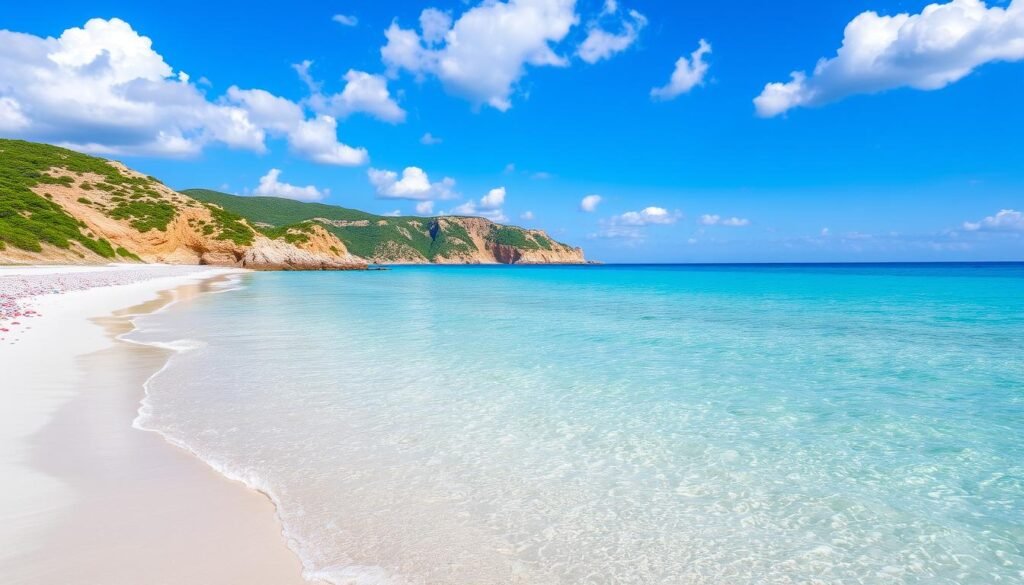
Greece’s Balos Beach in Crete is a favorite of mine. Its teal waters and white sand make it breathtaking. It’s also a safe place for monk seals and loggerhead sea turtles.
Plage de Palombaggia in Corsica offers a unique experience. Here, red boulders meet white sand and turquoise waters. It’s perfect for sunbathing with views of the Îles Cerbicale.
| Beach | Location | Unique Feature |
|---|---|---|
| Blue Lagoon | Malta | Remote, turquoise waters |
| Ölüdeniz | Turkey | Part of Turquoise Coast |
| Balos Beach | Crete, Greece | Wildlife sanctuary |
| Plage de Palombaggia | Corsica | Red boulders on white sand |
These Mediterranean spots are more than beautiful views. They offer a perfect place to connect with nature and enjoy sun, sand, and sea.
Atlantic Coast Wonders: Pristine Sands
I’ve found some amazing EU beaches along the Atlantic coast. They have pristine sands and offer eco-tourism. These places are great for responsible travel, with clean facilities and unforgettable experiences.
San Sebastian, Spain
San Sebastian’s beaches are a dream. From April to October, I was captivated by the golden sands and clear waters. The city cares about eco-tourism, with clean facilities and efforts to keep the coastline beautiful.
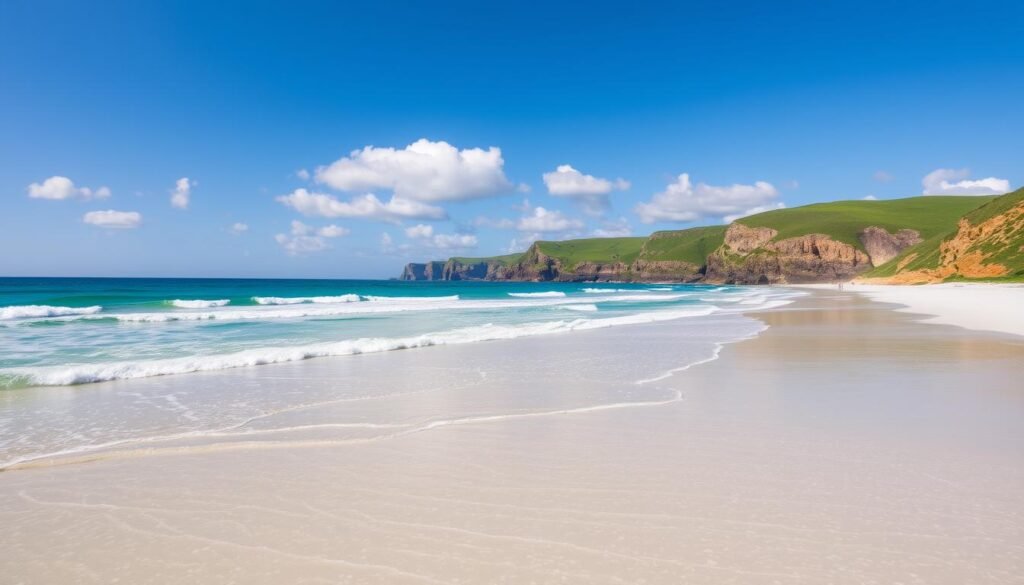
Algarve, Portugal
The Algarve in Portugal has stunning beaches. It’s perfect for visits from March to November. I was impressed by the region’s eco-friendly accommodations and activities.
Bay of Arcachon, France
My visit to the Bay of Arcachon from May to October was memorable. The clean waters and coastal landscapes amazed me. It shows how eco-tourism can thrive, preserving nature while offering great experiences.
These Atlantic coast wonders are more than beautiful beaches. They show the power of responsible travel and the need to protect our natural treasures for the future.
Sustainable Tourism Practices at Clean Beaches
I’ve found that Europe’s cleanest beaches are at the forefront of eco-tourism. They focus a lot on keeping the beaches clean. This is thanks to their efforts in waste management.
While traveling, I’ve seen how these beaches are changing. For example, Ibiza has many eco-friendly options for tourists:
- Hotels powered by solar energy to reduce carbon footprints
- Farm-to-table restaurants like Aubergine and Juntos House
- Eco-friendly transportation including bicycles, e-scooters, and electric car-sharing services
- Opportunities to join local beach clean-ups
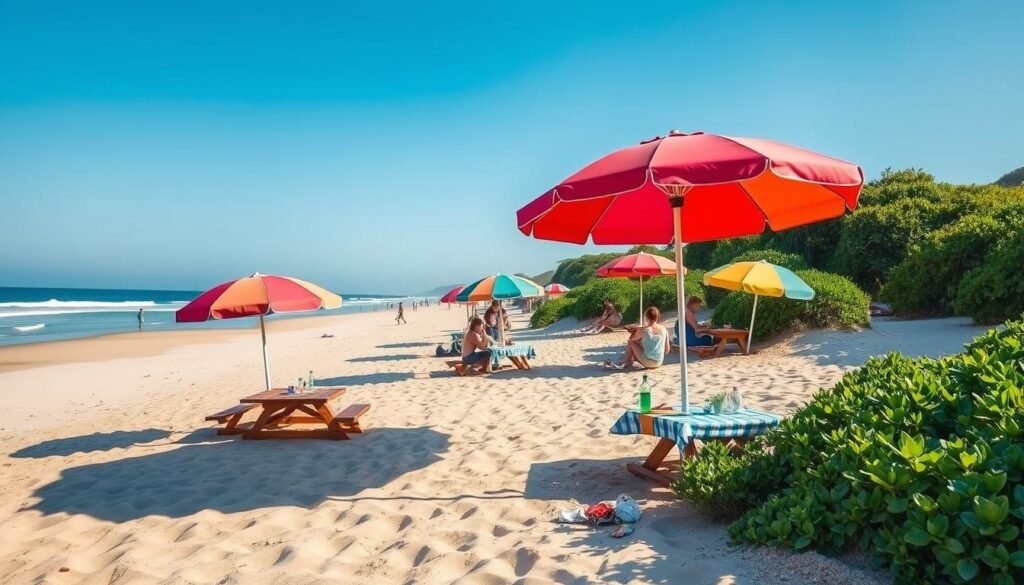
Across Europe, I’ve seen more volunteer workcamps for beach preservation. These camps last 2-6 weeks. They bring together people from all over to help the beaches.
Here’s a look at some workcamp options I’ve found:
| Country | Workcamp Focus | Key Activities |
|---|---|---|
| Iceland | Environment Protection | Visiting geothermal plants, environmental research |
| Spain | Marine Conservation | Wildlife monitoring, coastline cleaning |
| Slovenia | Festival of Sustainability | Gardening, farming, DIY workshops |
| Portugal | Climate and Sustainable Lifestyle | Supporting organic farms, learning organic food techniques |
| Austria | Forestry Conservation | Maintaining Green Belt biosphere reserve, mowing meadows |
These efforts help keep the beaches clean and teach visitors about being responsible. By joining these programs, I’ve learned a lot about the importance of tourism and nature.
Family-Friendly Clean Beaches in Europe
I’ve found some great family-friendly clean beaches in Europe for your next trip. These places are safe, fun, and comfy. They make family vacations unforgettable.
Safety Features
Safety is key for families. I’m glad to say 80% of these beaches have lifeguards during busy times. The waters are calm and shallow, perfect for kids to play safely.
Child-Friendly Activities
Kids will enjoy the soft sand at 70% of these beaches. It’s great for sandcastles and games. Some beaches, like Gerakas Beach in Zakynthos, let families see sea turtles nesting. It’s a rare and exciting experience!
Clean Facilities
Clean restrooms are essential for beach trips. All beaches I checked have cafes, restaurants, and places to rent sunbeds and umbrellas. This makes a day at the beach worry-free.
| Feature | Percentage of Beaches |
|---|---|
| Blue Flag Status | 60% |
| Lifeguards Present | 80% |
| Fine, Soft Sand | 70% |
| Nearby Amenities | 100% |
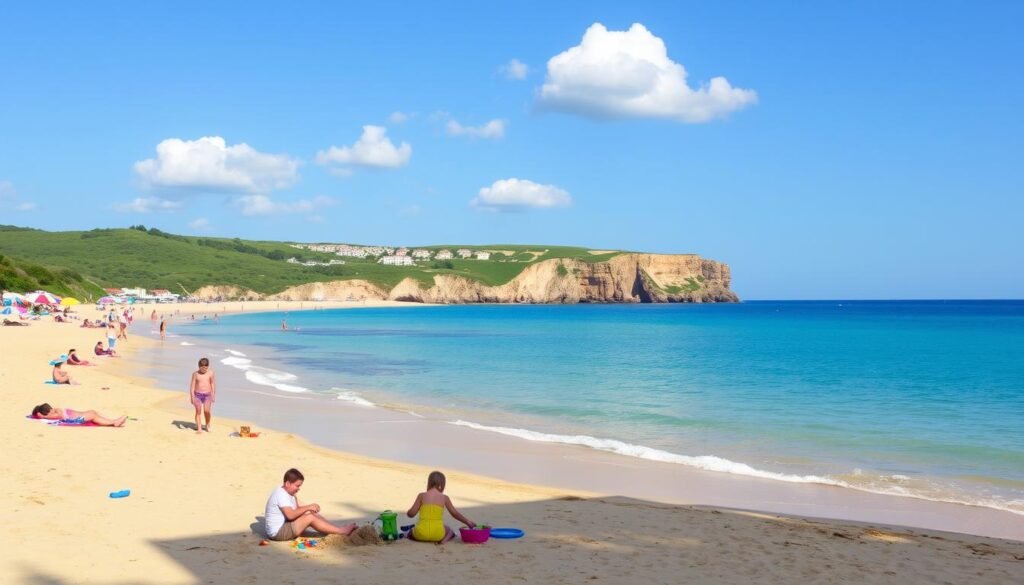
These beaches have an average water temperature of 25°C. They’re just a 38-minute drive from big towns. Whether you want a lively beach or a quiet spot, Europe’s cleanest beaches are perfect for families.
Off-the-Beaten-Path Clean Beach Destinations
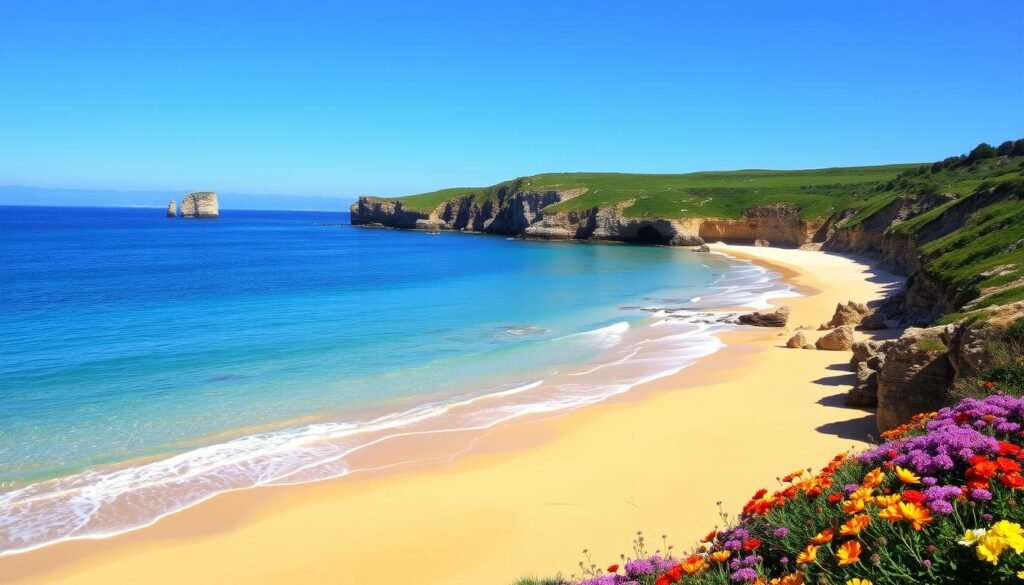
I’ve found some amazing hidden gems for beach lovers. These secluded spots offer a perfect escape from crowded places. Let’s look at some of Europe’s most untouched and eco-friendly beaches.
Rabbit Beach in Lampedusa, Italy, is a top pick. It’s hard to get to, which keeps it clean. The water is clear, and the sand is soft.
Calanque d’En Vau in France is great for adventure seekers. It takes two hours to hike or boat there. The turquoise waters and steep cliffs are breathtaking.
Lubenice Beach in Croatia is another gem. It’s a 45-minute hike down, so it’s rarely crowded. Plus, you can visit the Blue Cave nearby for a magical touch.
Red Beach in Iceland’s West Fjords is unique. The sand changes color with the weather. It’s a dream for photographers and shows nature’s beauty.
These places offer more than clean beaches. They let you connect with nature and avoid crowds. Remember to be responsible to keep these spots beautiful for others.
Best Times to Visit Europe’s Cleanest Beaches
Choosing the right time to visit Europe’s beaches is key. The best times vary, but I have some tips for you. They’ll help you plan a great beach vacation.
Spring and Early Summer
April to June is perfect for beach trips in Europe. The weather is nice, and there are fewer people. It’s a great time to visit places like Greece’s Elafonissi Beach.
In March, northern Europe is mild, and southern Europe is great for sightseeing.
Late Summer and Fall
August to October is my top choice for beach trips. The water is warm, and it’s calm. Places like Portugal’s Alentejo region are perfect.
Prices on flights and hotels are lower than in peak season.
Year-Round Options
Some beaches in Europe are good all year. The Canary Islands and Madeira have nice weather anytime. For something different, try Lithuania’s Nida beach in the off-season.
It’s one of the few places where you can really get away from it all. Enjoy the untouched nature.
FAQ
What makes a beach clean and eco-friendly?
What are some of the top cleanest beaches in Europe?
What are some sustainable tourism practices at clean beaches?
What makes a clean beach family-friendly?
Are there any off-the-beaten-path clean beach destinations in Europe?
When is the best time to visit Europe’s cleanest beaches?
Sources
- 40 of the best beaches in Europe – https://www.theguardian.com/travel/2022/apr/30/40-best-beaches-in-europe
- Green France: Clean Beaches – https://francetoday.com/travel/travel-features/green-france-clean-beaches/
- Bathing water quality – https://www.eea.europa.eu/en/topics/in-depth/bathing-water
- The Countries With The Cleanest Swimming Water In Europe, Ranked In A New Report – https://www.forbes.com/sites/laurabegleybloom/2024/07/31/the-countries-with-the-cleanest-swimming-water-in-europe-ranked-in-a-new-report/
- These are Europe’s cleanest swimming spots | CNN – https://www.cnn.com/travel/travel-news-europe-cleanest-swimming-spots/index.html

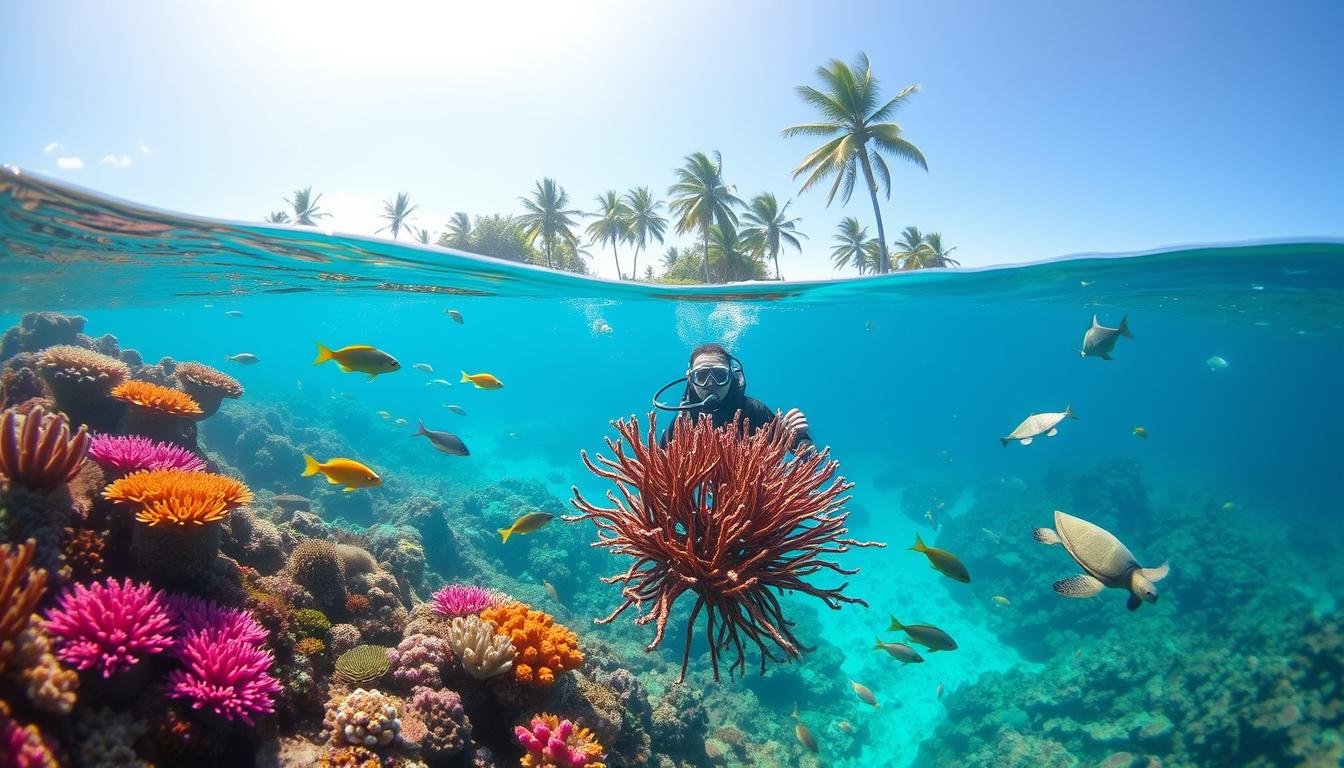
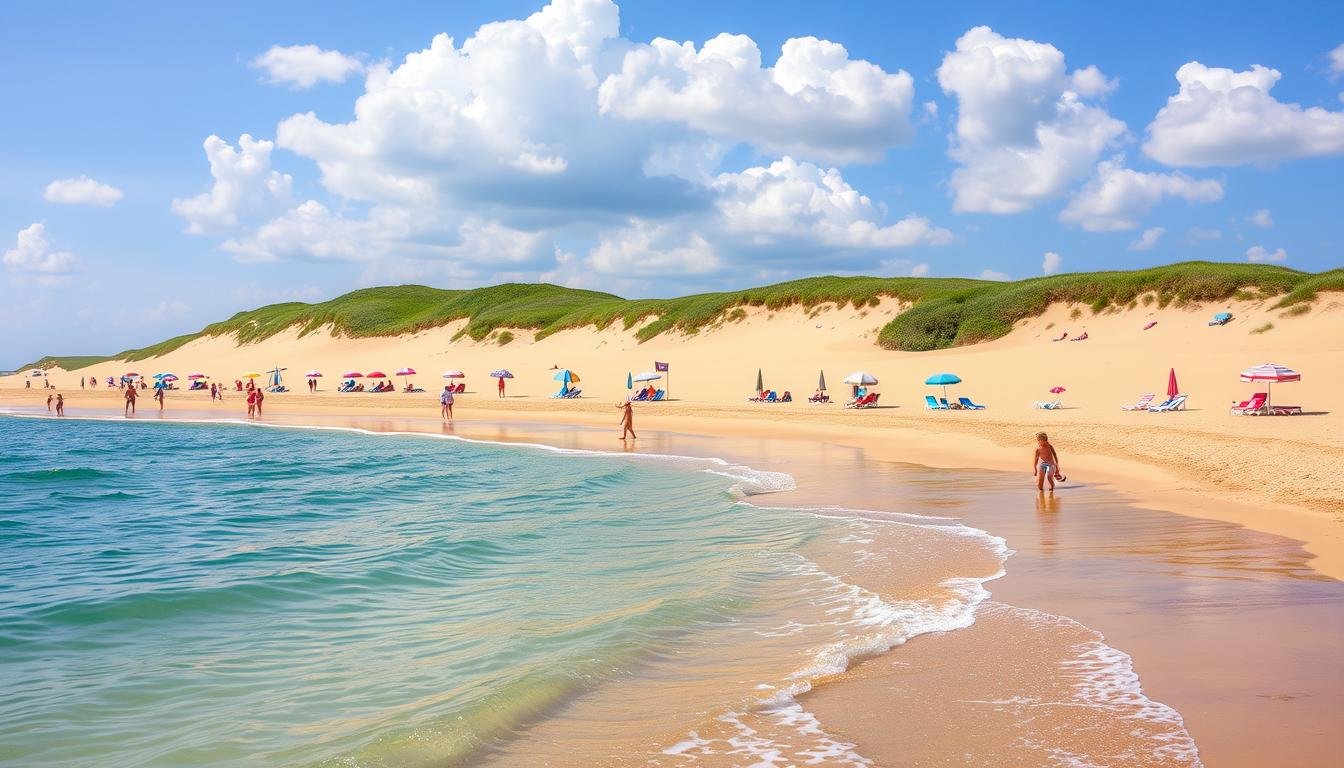
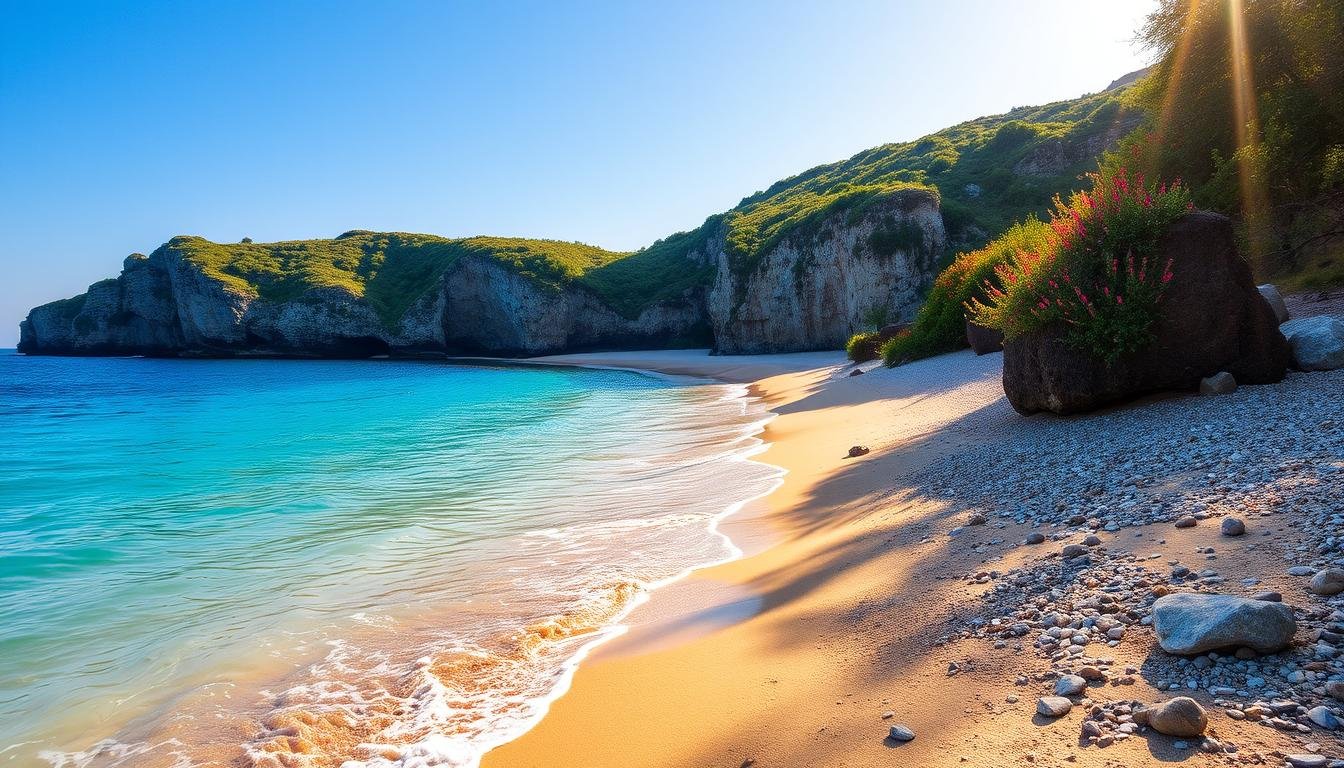
Leave a Reply